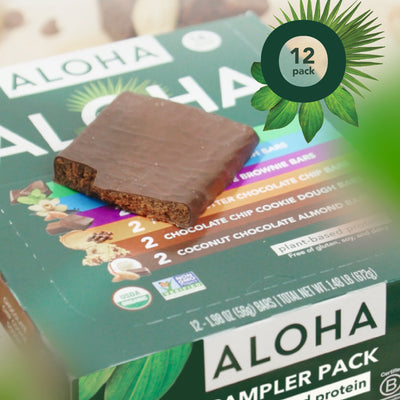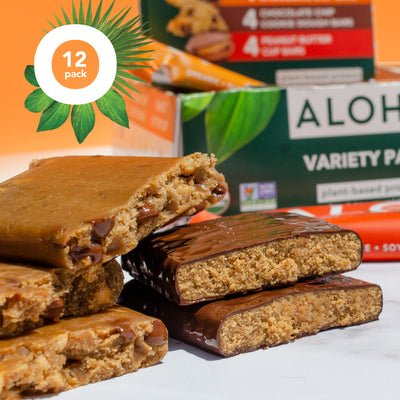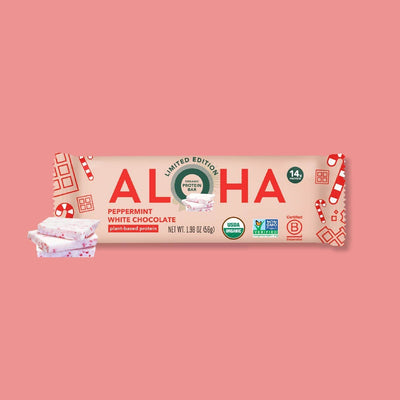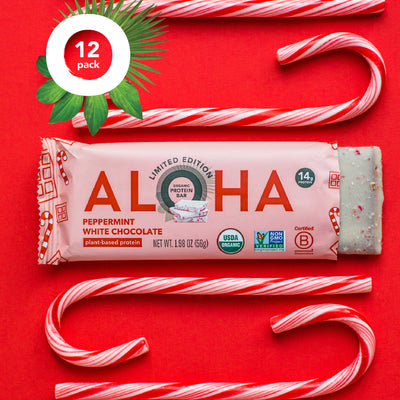Key Takeaways:
- Flavor Boost: Milk improves both the taste and creaminess of protein shakes for a more enjoyable drink.
- Nutritional Bonus: Dairy and plant-based milks add protein, calcium, and other important nutrients to your shake.
- Versatile Options: Milk blends well with many flavors and can support both quick shakes and smoothie-style meals.
Mixing protein powder with milk is a go-to method for anyone looking to make a shake that’s creamy, satisfying, and full of nutrients. Whether you’re starting your day, refueling after a workout, or just need something quick between meals, this combo delivers. The added richness of milk can improve both the flavor and texture of your shake, while offering extra benefits like calcium, vitamin D, and protein. With the right blend, it can feel more like a treat than a supplement.
At ALOHA, we make plant-based protein powders that mix easily with milk, water, or whatever works best for you. Our protein is made with organic ingredients, no artificial additives, and a smooth texture that tastes great on its own or as part of a recipe. We're a Certified B Corp and employee-owned, and we’re proud to put quality and sustainability at the center of everything we make.
In this piece, we’ll be discussing how to mix protein powder with milk, the best milk types to use, and a few tips to make your shake even better.
Can You Mix Protein Powder with Milk
Yes, you can mix protein powder with milk, and it’s actually one of the most popular ways to make a shake that tastes richer and keeps you feeling full longer. Milk adds creaminess and extra nutrients like calcium, potassium, and vitamin D, making it a great base for both dairy and plant-based protein powders.
Whether you prefer dairy milk or an alternative like almond, oat, or soy milk, the process is the same. Just add your scoop of protein powder to the milk and shake or blend until smooth. The result is a milk-based protein shake that’s thicker, more filling, and often more flavorful than mixing with water alone.
Many people find that milk helps balance the natural earthiness of plant-based protein powders like ALOHA. It’s also a great match for smoothies, coffee blends, or simply shaken on its own for a clean and satisfying snack or meal.
What Are the Benefits of Mixing Protein Powder in Milk
Mixing protein powder in milk adds both flavor and nutrition to your shake. The natural creaminess of milk helps smooth out the texture of the powder, making your drink more enjoyable without needing a blender. If you're using dairy milk, you're also getting extra protein, plus calcium, vitamin D, and other key nutrients.
Plant-based milks like almond, oat, or soy can bring their own benefits too. Almond milk is light and low in calories, oat milk adds natural sweetness, and soy milk brings a higher protein content. Each option lets you adjust the shake to match your goals, whether that's more fullness, better taste, or added vitamins.
This combo also makes your shake more satisfying. When paired with a quality protein powder like ALOHA’s, milk helps create a nutrient-packed drink that can work as a meal replacement, post-workout recovery, or an afternoon snack.
Best Types of Milk for Protein Powder Blends
The type of milk you use can change both the taste and nutrition of your protein shake. If you're going with dairy, whole milk creates the creamiest texture, while skim or low-fat options keep the shake lighter in calories. All dairy milk provides calcium, protein, and vitamin D, which supports bone health and overall recovery.
For non-dairy choices, almond milk is a popular go-to because it's low in calories and has a mild flavor that pairs well with most protein powders. Oat milk adds more thickness and natural sweetness, making it a good match for chocolate or vanilla blends. Soy milk offers the highest protein among plant-based milks and is great if you're looking for something more filling.
Coconut milk, though higher in fat, brings a rich, tropical taste and can be used to change up the flavor of your shake. No matter which you choose, make sure the milk is unsweetened if you want to keep your shake lower in sugar.
If you're looking for shake inspiration, check out our protein smoothie recipes to explore new blends.
How to Mix Protein Powder with Milk for the Smoothest Texture
To get a smooth protein powder and milk blend, the order you mix things matters. Start by adding your milk to the shaker or blender first, then add the protein powder. This helps prevent the powder from clumping at the bottom. If you're using a shaker bottle, give it a solid 20 to 30 seconds of shaking. A blender works even better if you're adding other ingredients like fruit or nut butter.
The temperature of the milk can also make a difference. Cold milk usually mixes better and improves the overall taste. If you're using a plant-based milk that separates easily, just give it a shake before pouring it in.
ALOHA’s plant-based protein is designed to mix easily without leaving gritty bits behind. Whether you’re making a basic shake or building something more elaborate, it blends into milk quickly to give you a creamy, satisfying drink.
Can You Use Milk in Hot Protein Drinks Like Coffee
Yes, you can mix protein powder with milk in hot drinks like coffee, but it helps to be careful with the temperature. Very hot liquids can make some protein powders clump or change texture. To avoid this, first stir or shake your protein powder with cold or room temperature milk, then slowly add the hot coffee while mixing.
This method works especially well for a protein coffee or latte-style drink. You get the creamy texture from the milk and a smooth protein boost without needing a blender. Just make sure you’re using a protein powder that holds up well in heat. ALOHA’s plant-based protein works great in warm drinks when mixed the right way.
Looking for ideas? Try our easy protein coffee recipe that combines bold flavor and clean ingredients for a morning routine you’ll actually look forward to.
How to Make a Milk-Based Protein Shake More Filling or Flavorful
If you’re looking to turn your shake into a full meal or simply want it to taste even better, there are easy ways to upgrade a milk-based protein shake. Adding fruit like bananas, berries, or mango can bring in natural sweetness and extra fiber. A spoonful of nut butter or chia seeds adds healthy fats and makes your shake more satisfying.
Spices like cinnamon or nutmeg, a splash of vanilla extract, or even a pinch of sea salt can elevate the flavor without adding much. For chocolate lovers, try a little unsweetened cocoa powder blended with oat milk and ALOHA's chocolate protein for a richer taste.
Texture matters too. Using frozen fruit instead of ice cubes keeps the shake thick without watering it down. For more flavor tips, check out our guide on how to make protein shakes taste better.
When Is It Better to Use Milk Instead of Water in a Shake
Milk is a great choice when you want a creamier texture, a richer flavor, or a more filling shake. It naturally adds nutrients like protein, calcium, and vitamin D, which can give your drink a more balanced nutritional profile. This makes milk a smart option when you’re using a shake as a meal replacement or post-workout recovery.
Water is better when you're in a hurry, want something lighter, or are keeping calories low. But if taste and satisfaction are your priority, milk often makes the shake feel more complete. Plant-based options like soy or oat milk also bring additional benefits like fiber or healthy fats, depending on the brand you choose.
Need help choosing your mix-ins? Our blog on what to mix protein powder with offers more ways to build your perfect shake.
Final Thoughts
Mixing protein powder with milk is one of the easiest ways to create a shake that feels satisfying, tastes great, and supports your nutrition goals. Whether you're keeping it simple or blending it with fruits and extras, using milk as your base brings creaminess and an extra boost of nutrients to every scoop.
ALOHA protein blends smoothly into dairy and plant-based milks alike. Made with organic, clean ingredients and no artificial sweeteners, it’s designed to support your day without adding anything unnecessary. Whether you’re heading out the door or sitting down to a post-workout snack, a milk-based shake can fit right into your routine.
Read also:
- Unveiling the Facts: Is Sunflower Oil Bad for You?
- Expert Insights: The Rise of Grain-Free Protein Bars
- Soft Protein Bars Explained: ALOHA's Secret Revealed
Frequently Asked Questions About Mixing Protein Powder with Milk
Is it safe to mix protein powder with raw milk?
Yes, but make sure the raw milk is from a trusted source. Otherwise, opt for pasteurized milk to reduce any risk of harmful bacteria.
Can I warm the milk before adding protein powder?
Slightly warm milk is fine, but avoid boiling temperatures. Too much heat can affect the texture of the shake and may cause clumping.
Does milk change how quickly protein is absorbed?
Milk may slow digestion slightly due to its fat content, but this isn’t a bad thing. It can help you feel full longer.
Can I use condensed or evaporated milk in my shake?
It’s possible, but those options are much higher in sugar and calories. Stick to regular or unsweetened plant-based milk for everyday use.
Is there a best time of day to drink a milk-based protein shake?
Any time works, but it’s especially helpful after workouts or as a morning meal when you need lasting energy.
Can kids or teens drink protein powder mixed with milk?
In general, yes. Just check the label to make sure the protein is age-appropriate and doesn't include added caffeine or artificial ingredients.
How long does a protein shake with milk stay fresh in the fridge?
It’s best within 24 hours. Shake well before drinking if it has been sitting, as natural separation may occur.
Can I use protein powder with flavored milk?
Yes, but flavored milk often contains added sugar. Be mindful of the total sweetness if you're also using a flavored protein powder.
Will using milk change the calorie count of my shake?
Yes. Milk adds calories, protein, and fat depending on the type. Always check the label if you’re tracking nutrition closely.
Is it better to use a blender or shaker for mixing with milk?
Both work. A blender gives a smoother texture, especially with add-ins, but a shaker is perfect for quick, no-fuss mixing.
Sources:
1. Lawrence, A. S., Russo-Batterham, D., Doyle, K., & Edoardo Tescari. (2025). Time to consider more than just calcium? The impact on protein, riboflavin, vitamin B12 and iodine intake of replacing cows’ milk with plant-based milk-like drinks—an Australian usual intake dietary modelling study. European Journal of Nutrition, 64(4). https://doi.org/10.1007/s00394-025-03697-8
2. Kanda, A., Nakayama, K., Sanbongi, C., Nagata, M., Ikegami, S., & Itoh, H. (2016). Effects of Whey, Caseinate, or Milk Protein Ingestion on Muscle Protein Synthesis after Exercise. Nutrients, 8(6), 339. https://doi.org/10.3390/nu8060339












